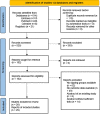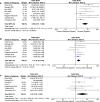Association between ambulatory blood pressure monitoring patterns with cognitive function and risk of dementia: a systematic review and meta-analysis
- PMID: 36995461
- PMCID: PMC10115699
- DOI: 10.1007/s40520-023-02361-7
Association between ambulatory blood pressure monitoring patterns with cognitive function and risk of dementia: a systematic review and meta-analysis
Abstract
Background: The objective of this systematic review and meta-analysis is to investigate whether nocturnal blood pressure fall, expressed by dipping patterns according to 24 h ambulatory blood pressure monitoring (ABPM), is associated with abnormal cognitive function (cognitive impairment or dementia).
Methods: We systematically searched PubMed, Embase, and Cochrane databases to identify original articles through December 2022. We included any study with at least ten participants reporting on all-cause dementia or cognitive impairment incidence (primary outcome) or validated cognitive tests (secondary outcome) among ABPM patterns. We assessed risk of bias using Newcastle-Ottawa Quality Assessment Scale. We pooled odds ratios (OR) and standardized mean differences (SMD) using random-effect models for primary and secondary outcome, respectively.
Results: In the qualitative synthesis, 28 studies examining 7595 patients were included. The pooled analysis of 18 studies showed that dippers had a 51% [OR 0.49(0.35-0.69)] lower risk of abnormal cognitive function and a 63% [OR 0.37(0.23-0.61)] lower risk of dementia alone, compared to non-dippers. Reverse dippers presented an up to sixfold higher risk [OR 6.06(3.15-11.64)] of abnormal cognitive function compared to dippers and an almost twofold higher risk [OR 1.81(1.26-2.6)] compared to non-dippers. Reverse dippers performed worse in global function neuropsychological tests compared with both dippers [SMD - 0.66(- 0.93 to - 0.39)] and non-dippers [SMD - 0.35(- 0.53 to - 0.16)].
Conclusion: Dysregulation of the normal circadian BP rhythm, specifically non-dipping and reverse dipping is associated with abnormal cognitive function. Further studies are required to determine potential underlying mechanisms and possible prognostic or therapeutic implications.
Protocol registration: PROSPERO database (ID: CRD42022310384).
Keywords: Ambulatory blood pressure measurement; Cognitive dysfunction; Dementia; Dipping patterns; Meta-analysis; Neuropsychological tests.
© 2023. The Author(s).
Conflict of interest statement
There are no competing interests for any author.
Figures





Similar articles
-
Antihypertensive withdrawal for the prevention of cognitive decline.Cochrane Database Syst Rev. 2016 Nov 1;11(11):CD011971. doi: 10.1002/14651858.CD011971.pub2. Cochrane Database Syst Rev. 2016. PMID: 27802359 Free PMC article.
-
Cholinesterase inhibitors for vascular dementia and other vascular cognitive impairments: a network meta-analysis.Cochrane Database Syst Rev. 2021 Feb 22;2(2):CD013306. doi: 10.1002/14651858.CD013306.pub2. Cochrane Database Syst Rev. 2021. PMID: 33704781 Free PMC article.
-
Pharmacotherapies for sleep disturbances in dementia.Cochrane Database Syst Rev. 2016 Nov 16;11(11):CD009178. doi: 10.1002/14651858.CD009178.pub3. Cochrane Database Syst Rev. 2016. Update in: Cochrane Database Syst Rev. 2020 Nov 15;11:CD009178. doi: 10.1002/14651858.CD009178.pub4. PMID: 27851868 Free PMC article. Updated.
-
Withdrawal or continuation of cholinesterase inhibitors or memantine or both, in people with dementia.Cochrane Database Syst Rev. 2021 Feb 3;2(2):CD009081. doi: 10.1002/14651858.CD009081.pub2. Cochrane Database Syst Rev. 2021. PMID: 35608903 Free PMC article.
-
Algorithm-based pain management for people with dementia in nursing homes.Cochrane Database Syst Rev. 2022 Apr 1;4(4):CD013339. doi: 10.1002/14651858.CD013339.pub2. Cochrane Database Syst Rev. 2022. PMID: 35363380 Free PMC article.
Cited by
-
Nocturnal blood pressure dipping, blood pressure variability, and cognitive function in early and middle-aged adults.J Clin Hypertens (Greenwich). 2024 Mar;26(3):235-240. doi: 10.1111/jch.14764. Epub 2024 Feb 8. J Clin Hypertens (Greenwich). 2024. PMID: 38332546 Free PMC article.
-
Hypertension: Causes and Consequences of Circadian Rhythms in Blood Pressure.Circ Res. 2024 Mar 15;134(6):810-832. doi: 10.1161/CIRCRESAHA.124.323515. Epub 2024 Mar 14. Circ Res. 2024. PMID: 38484034 Free PMC article. Review.
-
Blood Pressure and Cognitive Function in Older Adults.Clin Geriatr Med. 2024 Nov;40(4):597-613. doi: 10.1016/j.cger.2024.04.003. Epub 2024 May 9. Clin Geriatr Med. 2024. PMID: 39349034 Review.
-
Critical Review of the Methodological Shortcoming of Ambulatory Blood Pressure Monitoring and Cognitive Function Studies.Clocks Sleep. 2025 Mar 6;7(1):11. doi: 10.3390/clockssleep7010011. Clocks Sleep. 2025. PMID: 40136848 Free PMC article. Review.
-
Primary Arterial Hypertension Associated with Cognitive Dysfunction in Young Adults: Results from a Cross-Sectional Controlled Study.Behav Sci (Basel). 2024 Apr 12;14(4):321. doi: 10.3390/bs14040321. Behav Sci (Basel). 2024. PMID: 38667117 Free PMC article.
References
-
- World Health O . Dementia: a public health priority. Geneva: World Health Organization; 2012.
-
- Neuropathology Group (2001) Medical Research Council Cognitive F, Aging S. Pathological correlates of late-onset dementia in a multicentre, community-based population in England and Wales. Neuropathology Group of the Medical Research Council Cognitive Function and Ageing Study (MRC CFAS). Lancet 357:169–175 - PubMed
Publication types
MeSH terms
LinkOut - more resources
Full Text Sources
Medical

